September 1, 2009
We often get questions about the Pilot Parafoil. Why don’t they fly straight right out of the bag? Why do they start to lean? How do we make adjustments??
I’ll take a stab at answering the same questions later in this Update. But for those of you interested in both the art and the science of foil flight and tuning, I’ve re-printed much of a recent article by Peter Lynn on the subject.
How to design and tune parafoil style Pilot kites.
But first, should they be called “Pilot Kites”, or, more pejoratively, “Lifters”?.
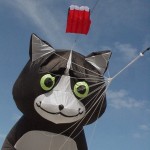 “Pilot” infers that the function of a top kite is guidance. “Lifter” implies that not only is the kite below unstable, but is also gravitationally challenged. Twenty years ago, there was a clear distinction between kites and line junk, but increasingly, top kites and the things beneath them have evolved a symbiotic relationship. Now, many show kites are almost never flown without a top kite to make launching easier, and so they can be flown lower where visual impact is greater.
“Pilot” infers that the function of a top kite is guidance. “Lifter” implies that not only is the kite below unstable, but is also gravitationally challenged. Twenty years ago, there was a clear distinction between kites and line junk, but increasingly, top kites and the things beneath them have evolved a symbiotic relationship. Now, many show kites are almost never flown without a top kite to make launching easier, and so they can be flown lower where visual impact is greater.
Pilots or Lifters then? They’re just names for one part of the system. Take your pick, I’ll stick with Pilot for now.
What then, are desirable characteristics for a Pilot?
- Stable over a wide wind range without adjustment Wind often starts light then gets stronger. And having to haul an entire train down to adjust an increasingly unstable pilot is definitely to be avoided.
- Good flying angle.
- Strong lift in light winds but then increasing at less than the square of wind speed (auto de-power).
- Cheap so that the risk of loss doesn’t much influence the decision to fly in difficult places and winds.
- Safe and inclined to under-correction rather than violent looping if the wind gets too strong.
- Easy to launch, and with good self recovery from turbulence induced collapses.
- As light as possible (less overweight baggage) and easy to pack.
- No tails or trailing drag devices to tangle and snag with other kites.
 By safety, packing and cost, the obvious best choice is parafoil style kites- and their flying angle, light end performance and auto-de-power are now about as good as for any other style. But their stability and collapse resistance is not yet equal to rokkaku’s and parasleds. Expecting that more development will probably close this gap, the following applies only to the parafoil style:
By safety, packing and cost, the obvious best choice is parafoil style kites- and their flying angle, light end performance and auto-de-power are now about as good as for any other style. But their stability and collapse resistance is not yet equal to rokkaku’s and parasleds. Expecting that more development will probably close this gap, the following applies only to the parafoil style:
Pilots are relatively simple kites that behave in generally predictable ways.
The basic rule for single line kite stability is that a kite’s weight force must act at a point below where it’s lift forces apply. And, it’s generally true that aerodynamic lift forces drive instability while drag forces stabilize. Increasing drag relative to lift will usually therefore improve stability
After this things get a bit messy — but not hopeless.
Considering changes by whether they cause a kite to overcorrect (and go into death spirals), or under-correct (and lean off to one side or the other and gradually descend) has cleared away one road block to understanding.
For Pilot parafoils it’s possible to be quite specific:
- Keels can increase or decrease overcorrection depending where they are placed, chordwise. More total keel area as a percentage of lifting area, will generally reduce overcorrection.
- Higher aspect ratio (width relative to length for a rectangular shape) decreases overcorrection.
- Bigger leading edge cell openings reduce overcorrection by providing drag to counteract any angular displacement. Outside cells will be particularly effective for this because the further from the center of rotation that the drag forces operate, the greater their overcorrection reducing effect will be.
- More camber (within reasonable limits) increases total lift, so will generally cause more overcorrection.
- Changing angle of attack can have such contradictory effects as to drive people who fly these kites to weird theories- almost religious in their absurdities sometimes.
The underlying effect can be easily understood though basic aerodynamics: As angle of attack reduces from say 30 degrees (a lot) to zero, there will be an angle, (which usually seems to be about 5 degrees or so for common Pilot style foils) at which lift relative to drag (the lift to drag ratio) is maximum.
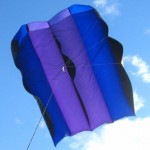 At higher angles, lift forces will be greater but drag forces will be proportionally greater still. At lower angles than this, drag will be less but lift will be proportionally less still. When a kite is flying at this optimum angle of attack it is therefore likely to be least stable. From this state, either reducing OR increasing the overall angle of attack will then reduce overcorrection type instability.
At higher angles, lift forces will be greater but drag forces will be proportionally greater still. At lower angles than this, drag will be less but lift will be proportionally less still. When a kite is flying at this optimum angle of attack it is therefore likely to be least stable. From this state, either reducing OR increasing the overall angle of attack will then reduce overcorrection type instability.
Now, say Joe has a green parafoil that is flying at more than the optimum angle of attack and it’s going right, then shortening the rear bridles (and/or lengthening the front bridles) on the left side will pull it left. But, if it’s flying at less than the optimum, this will make it pull even further to the right. And it gets worse. Kites can fly at more OR less than their optimum angle of attack depending on wind strength – the stronger the wind, the more the trailing edge of the kite is pushed up, reducing the angle. Therefore, changing the angle of attack of one side of a kite relative to the other as a way to steer it can have one effect in light winds and the opposite in strong winds.
So, Joe’s change works as expected one day but not the next- leading him to the strongly held belief that green kites fly to the right on even numbered days.
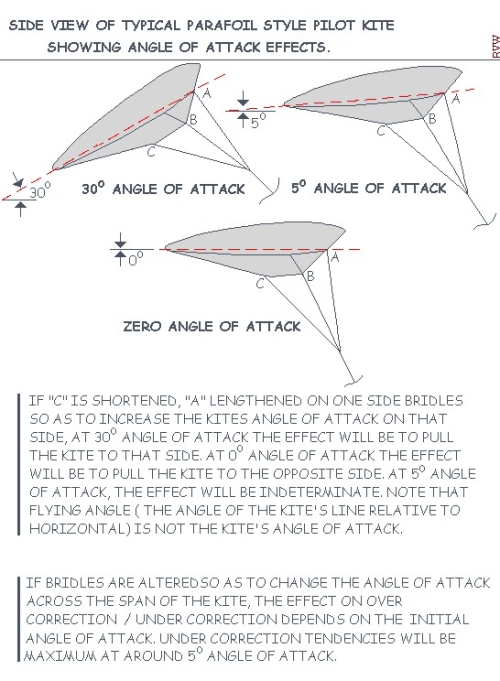
But there is a tuning system for these kites that is largely independent of angle of attack and hence of wind speed. This is to change the camber of one side relative to the other, without changing the angle of attack. If for example, a parafoil has 3 bridles per cell, (conventionally called A, B, and C), then pulling in B on one side outer cell without changing A or C will de-camber that cell and pull the kite towards that side. The reason this works is because, as from above, less camber means less lift, more drag. It’s usual to also let out the opposite side B by an equal amount because this doubles the effect (cambering up the weaker side), and preserves the kite’s average camber so won’t effect stability in general. And, pulling in or letting out all B’s without changing any other bridles will change the camber across the entire kite and can therefore be used to effect over-correction/under-correction.
Pulling in all B’s can tame even a viciously over-correcting kite, but it’s better to do this by increasing the depth of the leading edge openings, or increasing the kite’s aspect ratio, or adding more keel area. How much should B’s be changed by to get the required change? This depends. When a kite is already close to straight, as little as +/- 10mm will be noticeable (for an 8m standard PLK Pilot). If the amount required is more than about +/- 60mm on this size kite, then distortions can be so great as to cause stalls or luffs. In this case it’s necessary to use other means.
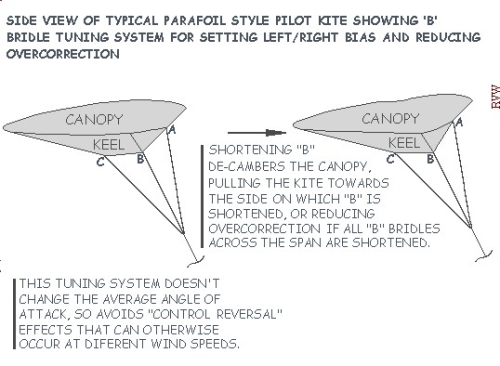
Also, this tuning system can be limited by the inherent rigidity of the inflated kite – sometimes for simple deep cell parafoils (as Pilots usually are) when B is pulled in a lot, A and/or B goes completely slack rather than the camber changing enough to pull the kite to left or right by the desired amount. Or, if B is let out a lot, rather than the camber on that side increasing , B just hangs slack and all loads are taken through A and C. In extreme cases, simultaneously shortening B and lengthening C on the same side can be effective. If even this isn’t enough, the last chance solution is to sew a pleat in the outside cell top skin at about half chord on the side opposite to the direction that the kite is leaning to. This will de-camber that cell even when bridle changes alone don’t have sufficient effect.
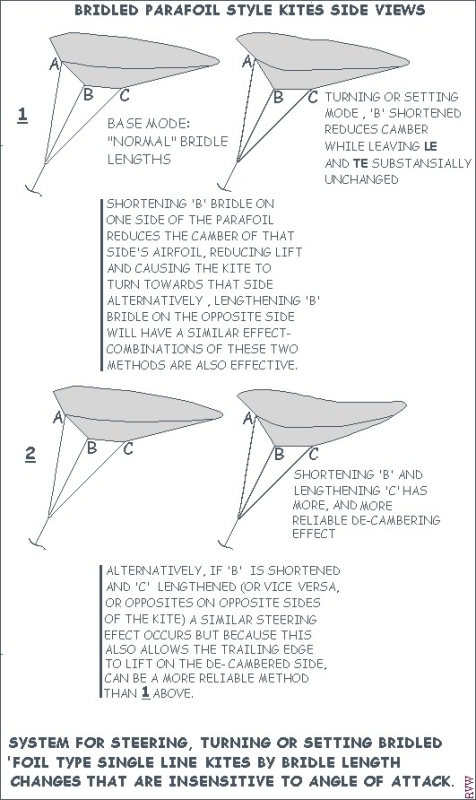
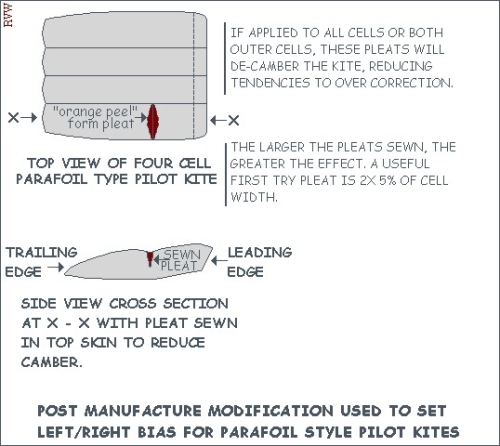
But why do kites tend to lean to one side or the other- why can’t they be made so as they fly straight to start with?
Both lift and drag forces increase with the square of wind speed, but a kite’s weight, it’s upward (downward, same difference) pointing force, stays the same and will eventually be overwhelmed. For even a (mythical) perfectly symmetrical kite there would be a wind speed at which it de-stabilises, if it doesn’t break first. For real world kites even unmeasurably small asymmetries will start to have their wicked way by 60km/hr or so. So, tuning systems are necessary – but it’s also sensible to avoid all obvious asymmetries during manufacture.
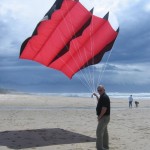 The main one is differential stretch that occurs between upper and lower pieces of fabric as they’re sewn together. It can be avoided by careful techniques, but usually isn’t. Even on a well set up walking foot machine, misregistration of 20mm/metre is common – more than enough to permanently skew the kite unless all sewing is managed symmetrically – ribs ALWAYS on top for example- and sewn front to back, say, to avoid end of seam bunching asymmetry.
The main one is differential stretch that occurs between upper and lower pieces of fabric as they’re sewn together. It can be avoided by careful techniques, but usually isn’t. Even on a well set up walking foot machine, misregistration of 20mm/metre is common – more than enough to permanently skew the kite unless all sewing is managed symmetrically – ribs ALWAYS on top for example- and sewn front to back, say, to avoid end of seam bunching asymmetry.
A secondary asymmetry is that fabric warp and weft are rarely at 90degrees. If they are at 80degrees- common enough for even high quality ripstop, then unless the fabric pieces are all cut and layed as mirror images, the kite will also get a terminal skew.
Other asymmetries come from differential bridle stretch (fixable) and fabric stretch – from heavy wind flying, trawling through water and pulling from trees (not fixable).
The tuning systems described above will generally deal with these last ones provided sewing and fabric asymmetry isn’t also present.
And, if we all take the trouble to do this, our Pilots will fly stably side by side rather than about one in four cutting across all the others by 30 degrees or so as happens now. Then we’ll be able to keep many more kites in the sky, festival organizers will be happy, relations between fliers will improve, and the world will be a better place. My next newsletter will be ‘Peace in the Middle East’.
Peter Lynn,
San Vito lo Capo, Sicily, May 31 ’09.
Reading this report from Peter, you’ll see that not all new kites will perform perfectly “out of the bag”. Moreover, once flown, kites will change based on the fabric weave, bridle line stretch, and wind power. Think of a new kite like a new pair of shoes that needs to be broken in.
Many of you have seen me field-tune a new kite. Simply inflate the kite in a smooth wind and hold the bridle at the tow point. Check to see if the canopy sits at an appropriate angle, that the kite orients perpendicular (ie straight) to the wind, and that all bridles are taught. (See the red Pilot photo above.)
If the kite leans to one side, tighten the lower bridle on the opposite side. One the orientation is correct, take up slack on all the other lines. Then simply tie an overhand knot in all the bridles. For the moment, ignore the ugly wad of lines below the knot. Attach your flying line to the new tow-point with a larkshead, launch the kite, and test performance at higher altitudes.
Small adjustments can also be made where the bridle lines connect to tabs on the sail. One the kite is performing correctly, it should not need further tuning for different winds. You can cut off the loose lines.
Happy flying,
David Gomberg
